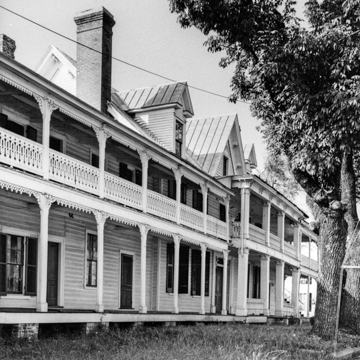A remarkable survival is this large version of the wooden taverns commonly built in Virginia courthouse towns and villages in the late eighteenth and nineteenth centuries. Alexander Boyd Jr. seems to have begun construction of the two-story tavern about a decade before the town was established. By 1812 the double-pile, center-hall main block had single-story wings with front doors entering noncommunicating rooms. In the 1870s, Holt raised the wings to two stories. Two-story porches running the full length of the wings and attached to the porch of the main block tie the building together. Subsequently a south (left) addition was constructed, incorporating a store that, like most of the tavern, survived the twentieth century with relatively little change.
You are here
Boyd Tavern
If SAH Archipedia has been useful to you, please consider supporting it.
SAH Archipedia tells the story of the United States through its buildings, landscapes, and cities. This freely available resource empowers the public with authoritative knowledge that deepens their understanding and appreciation of the built environment. But the Society of Architectural Historians, which created SAH Archipedia with University of Virginia Press, needs your support to maintain the high-caliber research, writing, photography, cartography, editing, design, and programming that make SAH Archipedia a trusted online resource available to all who value the history of place, heritage tourism, and learning.


